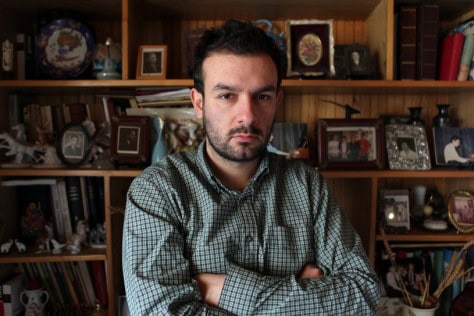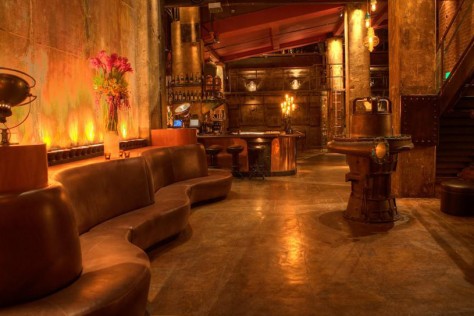Let’s begin by frustratingly asserting that there’s something physically arresting about an Elizabeth Huey painting that will never translate into the 2-D medium of a glossy magazine page. She uses wood as her canvas, huge planks that can stretch up to 9’ by 4’—and the size is a necessity rather than a touch of bravado, since each of Huey’s pieces host a History Channel’s worth of shadowy personages and deft references to the past. Her latest series, The Kirkbride Plan, constitutes interconnected segments of an alternate reality that all share a handful of common features: humans with delicately screen-printed faces; Tudor houses whose angles and perspectives have been distorted based on an unknown illogic; touches of the natural world (bushes, snippets of forest, densely opaque skies). Upon careful inspection (i.e., in Huey’s Brooklyn studio, standing nose-close to the canvas while the artist herself gives a sort of play-by-play), the paintings’ surfaces appear gouged, roughed up, multi-layered—she operates on the pigment with brushes and knives. These are artworks that beg the viewer to invest time examining the minutia.
It’s not necessary to know Elizabeth Huey’s own history in order to appreciate her work, but it does complicate and enrich the experience. Anyone who stumbled into her show last fall at Feigen Contemporary in Manhattan without A) reading her artist statement or B) having any clue whatsoever as to the identity of Thomas Kirkbride and his “plan,” would have come away oddly shaken and a bit confused. The series appears, at first, to involve a cast of characters abusing and mistreating each other in a number of creative ways—in one panel, a man held down to the ground has water dumped on his face by a crowd of captors; in another, a forlorn figure is bound to a chair with a box over his head. Other seemingly incongruous elements further muddy easy interpretations—in The Inquisition alone we have a computer, a tangle of subterranean neon piping, four dogs huddled together, a cluster of angels and a surveillance camera. Open Season boasts a yellow-jacketed hunter, another angel, two bunny rabbits and a woman with her internal organs exposed.
Even divorced from their context the works are haunting, privileged peeks into a fully-fleshed internal multiverse, but don’t get the wrong idea—this isn’t a case of the wild subconscious run rampant on the page, a la Henry Darger. For Elizabeth Huey, the painted world she’s created has its theoretical roots in the time she spent at a nightmarish youth institution founded by Mel Sembler. At the age of 15, a misbehaving Huey was shipped off to a Straight, Inc., a “treatment facility” innovated by Sembler that others have claimed resulted in emotional, physical and sexual abuses. Despite the controversy that later erupted thanks to ex-Straight activists, Sembler himself was well connected enough to score plum diplomatic jobs in both Australia and Italy, thanks to both Bushes—he also had a hand in shaping a good part of our modern anti-drug policy, and is currently in the midst of a lawsuit involving, believe it or not, eBay and a penis pump (see www.thestraights.com for first-person accounts and plenty of dirt). Huey’s formative experience led to an obsession with treatment centers, asylums and the history of mental health practice in America and beyond. “Straight, Inc. coerced parents into withdrawing their kids from school and placing them under 24-hour watch with ‘tough love’ group therapy, everyday, from 8am until midnight,” she says. “All groups were held in a windowless warehouse under florescent lights. The only thing pinned to the walls was a bastardized version of AA’s Twelve Steps. On first phase there was no showering or using the bathroom without being watched—no talking to the opposite sex, no books, magazines, radio or television, no walking outside.”
Despite this, it’d be a mistake to assume that work like The Kirkbride Plan is simply a form of individual therapy-in-action for Huey. “I’m not as interested in making art that exclusively isolates my own personal experience,” she explains. “I am interested in the fact that 50,000 teenagers were affected by Straight, but I’m also interested in the larger population of people that were affected historically in America, and continue to be affected, in various doctor/patient relationships.”
So those painted figures enacting images of what appears to be torture? They’re actually various techniques from the early days of mental health “treatment,” tactics like hydrotherapy and sensory deprivation. Reformers like Thomas Kirkbride campaigned for more humane methods—“moral treatment,” Huey explains, “meaning he wanted patients to be treated respectfully, and without violence.” The first asylum, London’s Bedlam, was launched by the Church, she notes, hence the presence of religious iconography in the series. “They didn’t understand mental illness, they just thought the person was possessed by the devil,” she says. “It’s about beating the devil out of someone.” Many of the screen-printed human heads are taken from archival photographs of female mental patients. “I decided to switch the roles and make the patients the doctors,” Huey says, holding up a screen-printing tray covered with row upon row of 19th century faces. “In some of the paintings I made them angels or nurses.”
The Tudor architecture that forms the backdrop to much of the series is also plucked from the historical record. “You have this old, alluring, fairy tale charm, coupled with this grid-like bar structure that resembles a prison,” Huey says. In many cases, the buildings are replicas of existing asylums—she’s currently in the midst of a new work in which the Tudor architecture of Sonoma State Hospital in California plays a large role. That facility engaged in radiation experiments on child patients during the 1950s and 60s. “I had a show in L.A. recently, and they said: your work’s too serious! People in Los Angeles aren’t interested in hospitals, no one wants to buy a hospital,” she laughs. The criticism is misleading—nothing could be further from the sterile white-walled monotony of a “hospital” than Huey’s dense color riot—and in any case, nothing in The Kirkbride Plan is preachy or didactic. While the work does have lessons to impart, ripe with enough references and thematic links to keep anyone Googling feverishly until 2020, it can also be celebrated on its own purely aesthetic terms.
“I would say that a lot of criticism I got at Yale and from other people [was], there’s too much going on! Settle down! Empty it out. A lot of people want me to make my work more minimal, and I’m not really interested in that,” she explains—and good thing, because it’s precisely the overstuffed and kinetic quality of Huey’s scenes that make them so wonderful, each one a cinematic frame of frozen motion. “I’m still in love with paintings and the ability for painting to act like a portal, the idea of this square [canvas] being a window.”
 Q&A with Larry Gus
Q&A with Larry Gus We Own the Night: The Edison
We Own the Night: The Edison
No Comments